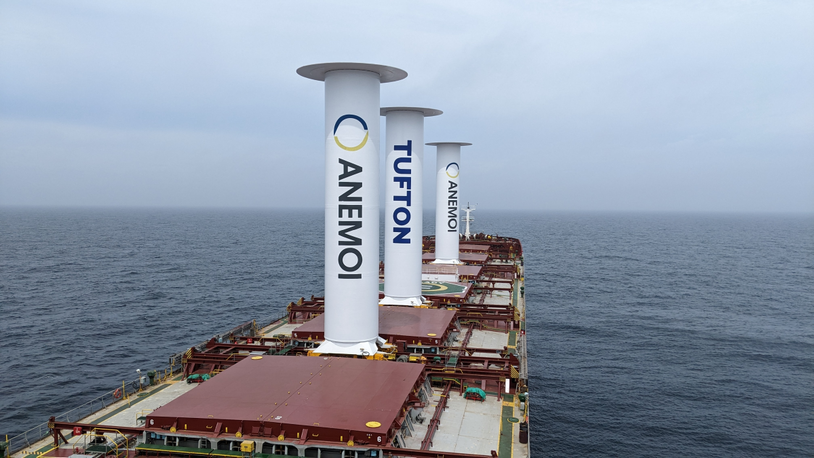Business Sectors
Contents
Compensator technology solves vibration problems
A range of anti-vibration devices are available for diesel engines – some of them even look good
A range of anti-vibration devices are available for diesel engines – some of them even look good
When optimising the vibration performance of a medium speed diesel engine, as many different contributing aspects as possible should be taken into account. A thorough vibration analysis includes the eigenfrequency and mode shape analysis, the analysis of excitation forces, and finally, as a combination, the dynamic forced response simulation.
The final result is always a compromise between many different criteria, says enginebuilder Wärtsilä. For example, the firing order giving the smallest free forces is most probably not the best one from the point of view of internal bending moments or torsional vibration.
Similarly, stiffening of the structure, in order to move one natural frequency away from a critical excitation, may create another natural frequency in another excitation frequency area. When it is not possible to tune the natural frequencies of an engine structure properly to avoid vibrations, and when modifying the excitation forces is not feasible, a tuned mass damper can be a good solution.
One of the best and most effective locations for a tuned mass damper is on the turbocharger, where the displacement amplitudes are normally much higher than on other parts of the engine. The tuned mass damper developed by Wärtsilä consists of vibrating mass discs supported by steel springs. Both are located, together with damping oil, inside a cylindrical steel frame. All the damper parameters can be separately adjusted and the damping coefficient is changed by altering the oil flow inside the damper.
The name ‘tuned mass damper’ refers to the construction, which consists of a vibrating mass with a natural frequency tuned to the desired frequency. When the damper is correctly tuned, it can reduce vibrations dramatically within the range of the resonance frequency and at more than one excitation frequency.
This is particularly so in the case of medium speed diesel engines, where the main excitation frequencies are spread over a wide range, and where some the vibration level harmonic orders are increased by the damper. However, with proper tuning of the mass, stiffness and damping parameters, it is possible to reduce this phenomenon.
Electric vibration compensation means freedom from conventional – and often not-so-effective – countermeasures, such as top-stays and structural reinforcement, says Danish marine specialist, Gertsen & Olufsen. Measures are necessary because of the inherent vibrations and twisting in diesel power plants which limit possible power output and can seriously increase wear and tear.
Most two-stroke diesel power plants, for example, have high levels of guide force X-moment caused by the gas force on the piston and by inertia. This force results in a transverse twisting of the engine top in an X-like shape, and many precautions are taken to avoid resonances on the engine, in auxiliary equipment and surrounding structures.
Most countermeasures address relief of the symptom rather than removing the vibration source, believes Gertsen & Olufsen. These have limited impact since they either transfer the vibrations or force to other parts of the structure or, worse, change the natural frequency of the whole construction.
Compensators outbalance the guide force X-moment and thereby eliminate the source of resonance, rather than relieve the symptoms, says this Danish company, which released its latest generation electric, vertical compensator in 2009. A total of 18 examples have now been supplied to shipbuilders in Brazil, Korea and China.
The C-200V1 covers the 25 to 200 kgm range but the company is looking to expand the range with the C-100V1 and C-600V1. The new designs have lower power consumption with a reversing electric motor, improved and faster circuits, easier maintenance based on a more effective construction and a redesigned gearbox.
While overall performance has increased, the basic construction of the company’s electric vibration compensator is still the same, based on two counter-rotating shafts. “These shafts make it possible to achieve needle point application with very accurate control of force and direction, and the next generation is thus characterised by a very precise phase angle control, especially in comparison to the systems based on a singular imbalance,” said Thorsten Larsen-Seul, managing director at Gertsen & Olufsen.
The compensators – two are required for guide force X-moments – are placed directly on the main engine to ensure that no forces or vibrations spread to other components. The advantage of a lever arm between the individual compensator and the engines’ rocking point is that a relatively small imbalance is required to outbalance the source. In most cases, it is recommended that previously installed top bracings or dampers are removed.
Moving on to the transmission train, torsional elastic couplings are generally mounted between engine and gearbox, and sometimes also between gearbox and propeller, reports the Austrian specialist, Geislinger. The aim is to eliminate torsional vibrations created either by the reciprocating engine or the propeller.
If the engine is elastically mounted, vibrations are generally transmitted via the hard-elastically mounted gearbox. In the case where a torsional elastic coupling is used, these vibrations are reduced. By combining a flexible coupling with low reaction forces, even softer foundations can be chosen to reduce structure-borne noise further.
Geislinger offers extensive support for the calculation of torsional vibrations and provides solutions to minimise them; the latter include the traditional, spring coupled Geislinger coupling, the Geislinger Carbotorq and the Gesilco product line. Weight considerations mean the Geislinger Carbotorq, Geislinger Shaft and Geislinger Membrane Coupling combination is the first choice, says the company, because as a unit, it provides the most lightweight drive train solution available.
With this arrangement, a cardanic system (where torque is transmitted between two parallel misaligned shafts without influencing the rotational speed) is achieved, which has very high misalignment capabilities and low weight. The system is available with ratings up to 5 kNm and all components are manufactured in-house.
The Geislinger Carbotorq uses silicone elastomer and, in comparison to other couplings, separates uniquely the misalignment function of the elastomer from the torsional elasticity. This is achieved through a pair of corrugated composite membranes, to which the elastomer is connected.
In case of misalignment, the corrugated membranes provide a cardanic system and thus the elastomer load (shear) is only minor compared to the conventional rubber coupling solutions. In this way, elasticity of the elastomer is dedicated to reducing the torsional vibrations only, resulting in lower stiffness and higher damping.
Together with the intermediate shaft and the second composite membrane, reaction forces below 50N in the radial direction and around 400N in the axial direction for full deflection are achieved. This enables the selection of very soft mountings for engine (and gearbox) to minimise structure-borne noise.
Composite materials also offer high internal damping so high-frequency vibrations, which could travel through the coupling under high load, are eliminated. The low weight and reaction forces also reduce the engine and gearbox bearing load, and this helps to extend component lifetime and reduce operation costs.
For the spring connected Geislinger coupling, a special design with single springs is used to reduce internal friction and provide very low stiffness. This helps eliminate high frequency vibrations. With a special back-to back arrangement for very sound-sensitive installations, the mass is concentrated towards either the driven or the driving part. The final arrangement is selected after an in-depth analysis of the torsional behaviour of the whole train – targeted to provide the most beneficial mechanical setup and lowest breakaway torques.
Because of their hydrodynamic damping, Geislinger couplings are able to provide broadband damping characteristics. This helps eliminate resonances which could be transmitted to the gearbox with other systems, claims the company. Furthermore, the oil supply helps to handle reliably the loss energy created by damping the torsional vibrations. The Geislinger coupling offers constant properties over a lifespan, which is very important for sound-sensitive installations.
Italian specialist Vibrostop has found that, as well as being used for naval applications, its anti-vibration mounts are even chosen by some luxury yacht owners because of their appealing look. The company has developed two different series of mounts: the MM and MMC. The MM types are used for loads ranging from 30 to 600kg, with typical installation natural frequency ranging of 5.5 to 8.5Hz. They protect installed equipment from vibration travelling across a hull and/or avoid the transmission of structural noise from equipment, such as pumps and transformers, to the ship.
The MMC series is a new mount designed to isolate equipment from both vibrations and shocks. It is used for loads ranging from 30 to 230kg, with typical installation natural frequency ranges from 5 to 7Hz. The geometry of this mount allows bigger deflection during a shock input, reducing an input impulse of around 100g x 5 msec to less than 10g on the suspended equipment.
New vibration technology continues to be developed for submarine applications, and Australia’s Collins class could benefit from new technology successfully developed at the University of Adelaide, Australia. Submarines are meticulously designed to remain undetectable but keeping such a large vessel quiet is a challenge.
The Collins class submarines are propelled by electric motors which makes them almost silent. During battery recharging operations, noise and vibration from the diesel-alternators reduce the stealth capabilities of the submarine.
The newly developed technology is an adaptive tuned vibration neutraliser, which can reduce vibration from the diesel engines reaching the submarine hull. The improvement in vibration attenuation is achieved passively, as opposed to an active vibration control system, which requires electrically powered vibration shakers to counteract the vibration. The newly developed adaptive-passive neutraliser automatically tunes itself to the frequency of the diesel engine vibration and only 12V is required to operate a microcontroller. MP
Related to this Story
CMB.Tech 'positive' on IMO's new framework, hails ammonia as 'the way forward'
IMO’s net-zero plan poised to pressure ageing fleet with rising costs
Events
Reefer container market outlook: Trade disruption, demand shifts & the role of technology
Asia Maritime & Offshore Webinar Week 2025
Marine Lubricants Webinar Week 2025
CO2 Shipping & Terminals Conference 2025
© 2024 Riviera Maritime Media Ltd.













